Statistical Bulletin - Reconviction Rates in Scotland: 2007-08 and 2008-09 Offender Cohorts
This publication provides detailed analyses of two year reconviction rates for offenders up to the 2007-08 cohort, as well as one year reconviction rates up to the 2008-09 cohort.
This document is part of a collection
3 Commentary on reconviction frequency rates and reconviction rates [3]
(Tables 1 to 16)
Overall reconviction frequency rates and reconviction rates
3.1 This bulletin provides more detailed analysis of reconvictions by focussing on the complementary measure of frequency of reconviction, in addition to the reconviction rate. While the reconviction rate provides an indication of progress in tackling offender recidivism at a global level, it may not be sensitive enough to detect individual-level progress as a result of interventions and programmes in the criminal justice system; such programmes may have been successful in reducing the frequency of reconviction, but not in stopping reconviction completely.
3.2 The reconviction frequency rate is presented here as the average number of reconvictions within a specified follow up period from the date of the index conviction per 100 offenders. For example, the 2008-09 one year reconviction frequency rate is 57.9 ( Table 1) and this means that there were 57.9 reconvictions in 2009-10 for every 100 offenders who had an index conviction in 2008-09.
3.3 This bulletin also focuses on a follow-up period of one year rather than two years as the one year rate tracks the two year rate (as shown below in Chart 2 and Chart 3) and is more timely. This makes it more useful in practice as it better reflects current patterns of reconviction and gives an earlier indication of potential change in the system, although it must be noted that the shorter follow up period will result in lower figures overall. There is also evidence from published material that the criminal justice system is processing cases faster, and this is particularly apparent in the Scottish Government publication of the 26 week target of Summary Court cases.
3.4 One year reconviction frequency rates and one year reconviction rates are the main focus of this bulletin. Two year rates are shown for key areas to ensure consistency with previously published figures and for reporting progress against the National Indicator for reconviction. There are also additional datasets, in the form of Excel worksheets, which accompany this publication. These contain a full set of tables with information on the one year reconviction frequency rates and one year reconviction rates, and two year reconviction frequency rates and two year reconviction rates.
3.5 There were 49,613 offenders discharged from custody or given a non-custodial sentence in 2008-09 ( Table 1). In the following year, these 49,613 offenders had 57.9 reconvictions for every 100 offenders, and the reconviction rate was 31.0 per cent.
3.6 Over the past seven years the number of offenders discharged from custody or given a non-custodial sentence increased from 44,854 in 2002-03 to 53,247 in 2006-07 but has since declined to 49,613 in 2008-09. During this period, there has generally been a decline in the one year reconviction frequency rate and a corresponding decline in the one year reconviction rate ( Table 1 and Chart 2).
3.7 In 2002-03, the reconviction frequency rate was 63.9 and the reconviction rate was 32.9 per cent, whereas in 2008-09 they are 57.9 reconvictions per 100 offenders and 31.0 per cent respectively. Overall, this shows that there has been a reduction of 6 reconvictions for every 100 offenders between 2002-03 and 2008-09, and a decrease in offender reconviction by 1.9 percentage points.
Chart 2 One year reconviction frequency rates and one year reconviction rates
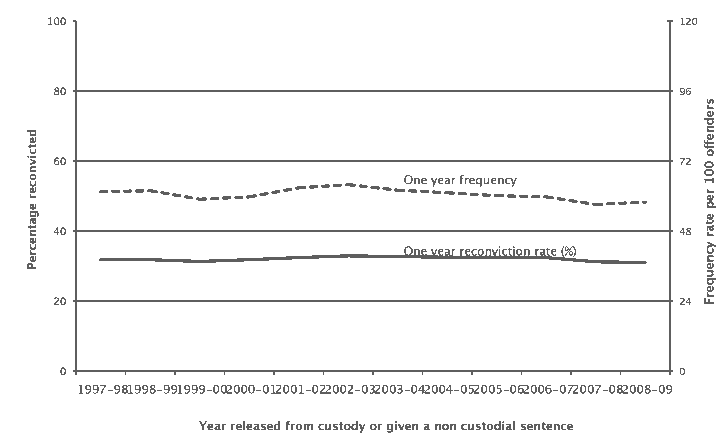
Chart 3 Two year reconviction frequency rates and two year reconviction rates
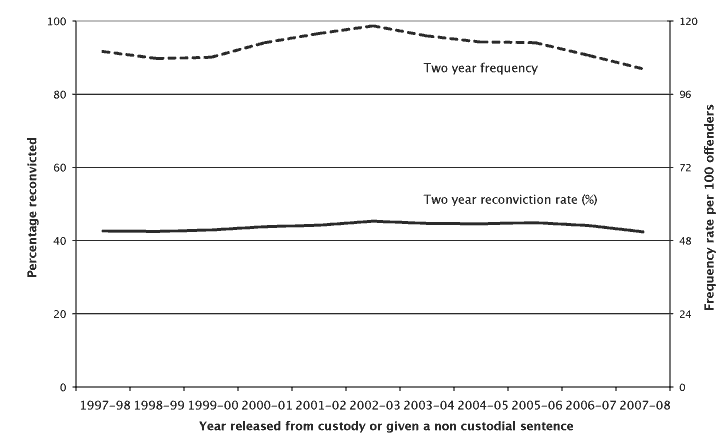
Reconviction frequency rates and reconviction rates by age
3.8 Those aged under 21 have the highest reconviction frequency rate and the highest reconviction rate ( Table 2 and Chart 4). The reconviction frequency rate is 70.3 in 2008-09, a fall of 1.5 reconvictions for every 100 offenders since 2007-08. The reconviction rate for this age group is 37.4 per cent in 2008-09, a fall of 0.8 percentage points since 2007-08.
3.9 In 1997-98 there was a marked difference in the level of reconviction between those offenders aged under 21, against those aged 21 and over. However, in 2008-09 the difference in reconviction between these two age groups is not as pronounced. In 1997-98 the reconviction frequency rate for the under 21 age group was 93.4 and for those aged over 21 it ranged from 39.7 to 63.1. However, in 2008-09 the reconviction frequency rate for the under 21 age group was 70.3 and for those aged over 21 it ranged from 46.0 to 63.1. Therefore, this marked difference is largely because of a striking fall in the number of reconvictions for the under 21 age group. In 1997-98 this group had a reconviction frequency rate of 93.4 and in 2008-09 the reconviction frequency rate is 70.3; a fall of about 23 reconvictions for every 100 offenders over an 11 year period.
3.10 Over the past seven years there has also been a decline in reconviction frequency rate for those offenders who are aged 21 to 25. In 2002-03 the one year reconviction frequency rate was 73.8 and in 2008-09 it is 63.1 (a return to the level of reconviction frequency rate in 1997-98). Overall, for those aged between 21 and 25, this shows that there has been a reduction of over 10 reconvictions for every 100 of these offenders.
Chart 4 One year reconviction frequency rates by age: 1997-98 to 2008-09 cohorts
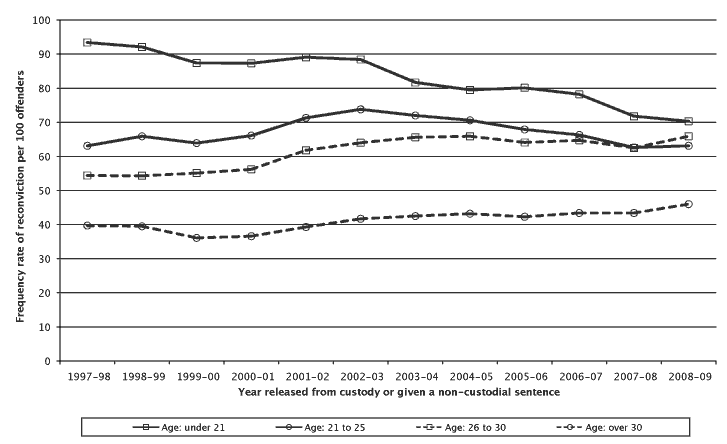
3.11 There has also been a decline in the one year reconviction rate between 2002-03 and 2008-09. The one year reconviction rates for 2002-03 were 41.3 and 37.1 per cent for the under 21 and 21 to 25 age groups respectively, and the reconviction rates for 2008-09 were 37.4 and 33.8 per cent for the two age groups.
3.12 Conversely, over the past seven years there has been an increase in reconviction frequency rate for those offenders aged over 30. In 2002-03, the one year reconviction frequency rate was 41.7, and in 2008-09 it is 46.0. Overall, this shows that there has been an increase of over 4 reconvictions for every 100 of these offenders between 2002-03 and 2008-09.
Reconviction frequency rate and reconviction rates by sex and age
3.13 Males aged under 21 have the highest reconviction frequency rate and the highest reconviction rate ( Table 3). The reconviction frequency rate is 73.7 in 2008-09, and the reconviction rate for this age group is 39.1 per cent.
3.14 Between 2006-07 and 2008-09 there has been a slight decline in the reconviction frequency rate for those female offenders who are aged 25 and under ( Table 4 and Chart 5). The under 21 age group declined from 54.5 to 49.5 and the 21 to 25 age group declined from 65.7 to 60.5. During the same period there has been a slight increase in the reconviction frequency rate for those aged 26 and over (the 26 to 30 age group increased from 55.7 to 60.6, and the over 30 age group increased from 37.4 to 41.4, although there was a slight dip in 2007-08).
Chart 5 One year reconviction frequency rates, females by age: 1997-98 to 2008-09 cohorts
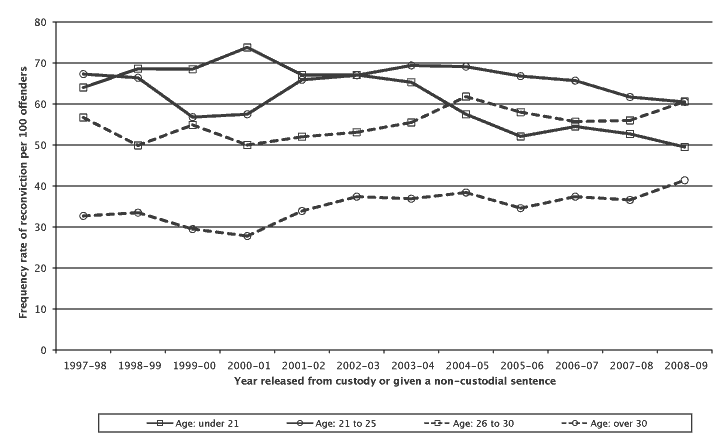
Reconviction frequency rate and reconviction rates by index disposal
3.15 Offenders given a DTTO have the highest reconviction frequency rate and the highest reconviction rate compared to the other disposals ( Table 5 and Chart 6). The reconviction frequency rate is 162.3 in 2008-09, and the reconviction rate is 63.9 per cent.
3.16 Over time there has been a decline in the reconviction frequency rate for those offenders who are given a DTTO. These orders were rolled out to Glasgow, Fife and Aberdeen between 1999 and 2002, and Edinburgh, Renfrewshire, Inverclyde and Tayside in 2002-03. In 2002-03 the one year reconviction frequency rate was 240.6 and in 2008-09 the rate is 162.3. Overall, for those given a DTTO, this shows that there has been a reduction of nearly 80 reconvictions for every 100 of these offenders.
3.17 There has also been a decline in reconviction rates for those given DTTOs. The one year reconviction rate for 2003-04 was 79.1 per cent, and the reconviction rate for 2008-09 was 63.9 per cent.
3.18 The reconviction frequency rate for offenders given a custodial sentence or a probation order are of a similar magnitude. The reconviction frequency rates are 96.0 and 86.0 respectively for these disposals in 2008-09. On the other hand, the reconviction frequency rate for offenders given a community service order is 42.5 for every 100 offenders in 2008-09.
3.19 The reconviction frequency rate for all disposals show some evidence of a decline since 2002-03.
Chart 6 One year reconviction frequency rates by disposal: 1997-98 to 2008-09 cohorts
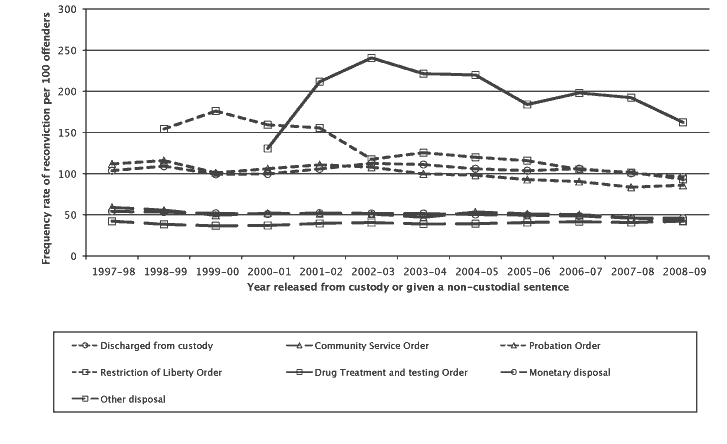
Reconviction frequency rates and reconviction rates by index crime
3.20 Offenders who committed a crime of dishonesty have the highest reconviction frequency rate and the highest reconviction rate compared to those who committed other crimes ( Table 6). The reconviction frequency rate is 101.3 for offenders who committed crimes of dishonesty in 2008-09, and the reconviction rate is 44.1 per cent.
3.21 Offenders who committed a sexual crime have the lowest reconviction frequency rate and the lowest reconviction rate compared to those who committed other crimes. The reconviction frequency rate is 18.2 for those who committed a sexual crime in 2008-09, and the reconviction rate is 12.2 per cent.
3.22 Offenders who committed crimes other than sexual crimes or crimes of dishonesty in 2008-09 have a reconviction frequency rate between 40 and 60. The reconviction rates are between 25 and 35 per cent.
Reconviction frequency rates and reconviction rates by sentence length
3.23 Offenders who were released from a custodial sentence of 3 months or less have the highest reconviction frequency rate and the highest reconviction rate compared to those who were released from longer sentences ( Table 7). For those on these short sentences the reconviction frequency rate is 135.3 in 2008-09, and the reconviction rate is 59.1 per cent. On the other hand, those released from sentences of over 6 months to 2 years had a reconviction frequency rate of 71.5 in 2008-09.
3.24 In recent years there is some evidence of a reduction in the reconviction frequency rate for offenders who were released from a custodial sentence of 3 months or less. In 2003-04 the reconviction frequency rate was 151.1 and in 2008-09 it has declined to 135.3. In five years, a reduction of nearly 15 reconvictions for every 100 offenders.
Reconviction frequency rates and reconviction rates by number and type of previous convictions
The 2010 publication "Reconviction rates in Scotland: 2006-07 and 2007-08 Offender cohorts" provided statistics on the two year reconviction rates by number and type of previous convictions. In this bulletin, statistics are provided on the one year reconviction rates by number and type of previous convictions. However, to ensure that there isn't a gap in the statistics, information is provided on the one year reconviction rates for the 2007-08 cohort as well as the 2008-09 cohort ( Tables 11 and 12).
3.25 Offenders with a history of convictions have the highest reconviction frequency rate and the highest reconviction rate ( Tables 8 to 12, and Chart 7). Those offenders with over 10 previous convictions in 2008-09 had a reconviction frequency rate of 125.9. The reconviction rate is 57.1 per cent for this cohort in 2008-09.
3.26 Over time there is some evidence of a reduction in the reconviction frequency rate for offenders who had over 10 previous convictions. In 1997-98 the reconviction frequency rate was 156.0, and in 2008-09 this has declined to 125.9. In eleven years, a reduction of over 30 reconvictions for every 100 of these prolific offenders.
3.27 The reconviction frequency rate declines as the number of previous convictions decline. Offenders who had no previous convictions have the lowest reconviction frequency rate and the lowest reconviction rate. The reconviction frequency rate is 22.8 in 2008-09, and the reconviction rate was 14.7 per cent.
Reconviction frequency rates and reconviction rates by local geographic breakdown
The 2010 publication "Reconviction rates in Scotland: 2006-07 and 2007-08 Offender cohorts" provided statistics on the two year reconviction rates by Community Justice Authority ( CJA) and local authority, and by police force of index conviction. In this bulletin, statistics are provided on the one year reconviction rates by CJA and local authority, and by police force of index conviction. However, to ensure that there isn't a gap in the statistics, information is provided on the one year reconviction rates for the 2007-08 cohort as well as the 2008-09 cohort ( Tables 13 to 16).
3.28 This analysis compares reconviction frequency rate and reconviction rates across approximate local authority areas, CJAs and police forces, based on the location of the court where the index conviction was heard. Whilst this approach provides a useful estimate for these areas, it is important to note that an offender may not always be supervised in the area in which they are convicted and, additionally, subsequent reconvictions may have occurred in different areas. The characteristics of offenders are also likely to vary across these areas.
3.29 The 2007-08 cohort can be grouped into approximate local authority areas according to the court of the offenders index conviction, as in Table 13 and described in its footnotes. The two highest reconviction frequency rates and reconviction rates were for offenders whose index conviction was given at courts in the Clackmannanshire area and the Dundee City area, and the lowest reconviction frequency rate and the lowest reconviction rate was for offenders whose index conviction was received at a court in Shetland. The 2008-09 cohort has similarly been grouped into approximate local authority areas, as in Table 14. Again the highest rates were for offenders whose index conviction was given at courts in the Clackmannanshire area and the Dundee City area, and the lowest rate was for offenders whose index conviction was received at a court in Orkney. However, such comparisons between areas should be treated with caution as they take no account of the inherent variability in measuring reconviction rates, and it is suggested that a method which takes this into account should be employed (see Section 5).
Chart 7 One year reconviction frequency rates by previous convictions: 1997-98 to 2008-09 cohorts
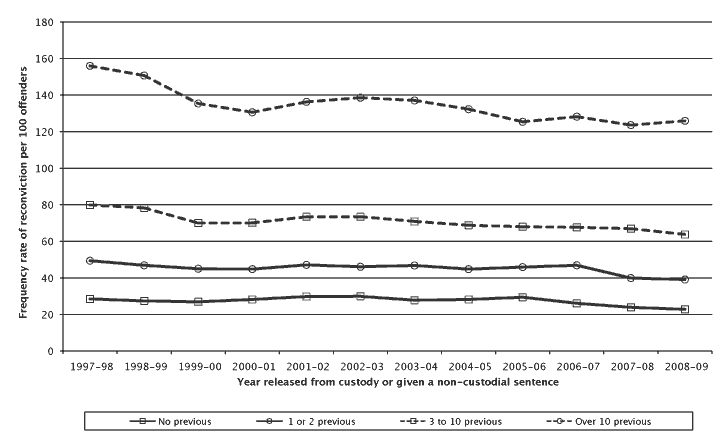
3.30 Table 13 also includes measures of the reconviction frequency rate and reconviction rate at the CJA level for the 2007-08 cohort. It shows that the highest reconviction frequency rate is in Tayside CJA (67.0), whereas the lowest is in Lothian and Borders CJA (47.7). The reconviction rate is also highest for Tayside CJA (34 per cent) and lowest for Lothian and Borders CJA (27 per cent). The 2008-09 cohort provides similar results, as shown in Table 14; the highest reconviction frequency rate is in Tayside CJA (74.2), whereas the lowest is in Lothian and Borders CJA (50.0). The reconviction rate is also highest for Tayside CJA (36 per cent) and lowest for Lothian and Borders CJA (27 per cent).
3.31 Table 15 includes measures of the reconviction frequency rate and reconviction rate at the police force level for the 2007-08 cohort. It shows that the highest reconviction frequency rate is in Central Scotland Police force (67.1), whereas the lowest is in Lothian and Borders Police (48.7). The reconviction rate is also highest for Central Scotland Police (35 per cent) and lowest for Lothian and Borders Police (28 per cent). The 2008-09 cohort provides similar results, as shown in Table 16; the highest reconviction frequency rate is in Tayside Police force (73.6), whereas the lowest is in Northern Constabulary (47.7). The reconviction rate is also highest for Tayside (36 per cent), however the lowest is for Lothian and Borders Police force (28 per cent). This suggests that there were fewer reconvictions for the 2008-09 cohort in Northern Constabulary compared to Lothian and Borders Police, but there were a similar number of offenders in both of these police force areas.
Two year reconviction frequency rates and reconviction rates
3.32 Since 2002-03 there has been a decline in the two year reconviction frequency rate and a corresponding decline in the two year reconviction rate ( Table 17 and Chart 3). In 2002-03 the reconviction frequency rate was 118.4 and the reconviction rate was 45.3 per cent whereas in 2007-08 these were 104.3 and 42.4 per cent respectively. Overall, this shows that there has been a reduction of just over 14 reconvictions for every 100 offenders between 2002-03 and 2007-08, and a decrease in offender reconviction by 2.9 percentage points.
Reconviction rates for main crimes and other crimes resulting in a conviction
3.33 In 2007-08 offenders who were convicted of prostitution, housebreaking and shoplifting had the highest two year reconviction rates ( Table 18). Those convicted of these crimes had two year reconviction rates of 79, 68 and 68 per cent respectively.
3.34 Fifty two per cent of offenders who were convicted of shoplifting in 2007-08 were reconvicted of at least one other crime of dishonesty within two years.
There is a problem
Thanks for your feedback